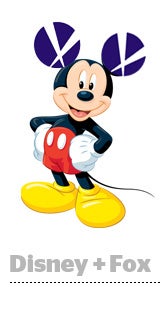Nearly everything Disney does these days seems to be for the love of DTC.
CEO Bob Iger told investors on Wednesday that acquiring 21st Century Fox’s entertainment assets for $71 billion will create synergies for Disney’s direct-to-consumer streaming vision.
“I feel really confident in our plans and the plans we’ve announced, because of what we bought,” Iger said.
Fox’s entertainment assets include strong content brands, like Nat Geo and “The Simpsons,” a 30% share in Hulu (bringing Disney’s total stake to 60%) and Indian TV broadcaster Star plus its streaming service, Hotstar.
Iger also emphasized onboarding Fox’s executive talent, including Uday Shankar, CEO of Star and the newly appointed president of Disney’s Asia Pacific unit.
Shankar took the stage during Disney investor day event in April, where he and other execs preached the DTC gospel.
“From the beginning, we analyzed [the Fox] acquisition through the lens of our new strategy,” Iger said.
But, just as Disney warned investors last month, DTC might be cheap for the end user – the Disney+ service will cost $6.99 per month when it launches on Nov. 12 – it’s having an impact on the bottom line as Disney ramps its content investment in both Disney+ and ESPN+.
Disney plans to spend $1 billion on original content for its streaming platform next year and grow that amount to more than $2 billion by 2024.
Results for the second quarter reflect these and other ongoing investments in Disney’s streaming platforms, as well as losses from the consolidation of Hulu, said Disney CFO Christine McCarthy.
Although overall revenue rose 3% to $14.92 billion, beating expectations, and DTC and international revenue (Disney bundles the two into one division) increased 15% to $955 million, losses more than doubled year over year to $393 million, which was only partially offset by an increase in Disney’s international business. The losses are a reflection of the money Disney is pouring into its streaming services.
AdExchanger Daily
Get our editors’ roundup delivered to your inbox every weekday.
Daily Roundup
But Disney is clearly ready to spend money to make money as the streaming puzzle pieces fall into place.
Not long after Disney first announced its intention in 2017 to buy a controlling interest in BAMTech (now Disney streaming services) and launch Disney+ and ESPN+, Iger and his team kicked around the idea of buying Fox, so they already had streaming firmly on the brain.
“We were able to, in analyzing the value,” Iger said, “really think hard about how we might use or leverage both the content we were buying – I’m talking about the library – the brands we were buying and the titles, but also the people at Fox, who are so critical to allowing us to fulfill our goals as related to DTC.”














